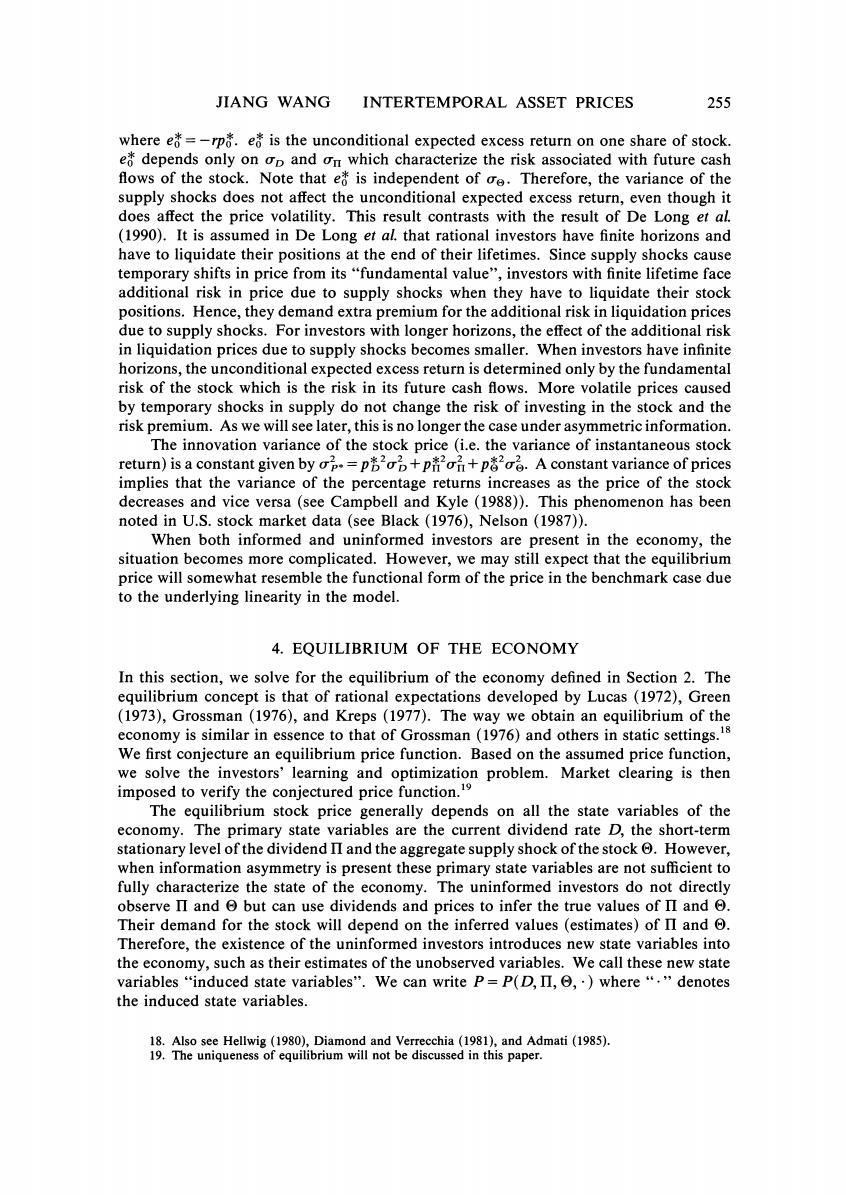正在加载图片...

JIANG WANG INTERTEMPORAL ASSET PRICES 255 where e=-rpa.e is the unconditional expected excess return on one share of stock. e depends only on op and on which characterize the risk associated with future cash flows of the stock.Note that e is independent of oe.Therefore,the variance of the supply shocks does not affect the unconditional expected excess return,even though it does affect the price volatility.This result contrasts with the result of De Long et al. (1990).It is assumed in De Long et al.that rational investors have finite horizons and have to liquidate their positions at the end of their lifetimes.Since supply shocks cause temporary shifts in price from its "fundamental value",investors with finite lifetime face additional risk in price due to supply shocks when they have to liquidate their stock positions.Hence,they demand extra premium for the additional risk in liquidation prices due to supply shocks.For investors with longer horizons,the effect of the additional risk in liquidation prices due to supply shocks becomes smaller.When investors have infinite horizons,the unconditional expected excess return is determined only by the fundamental risk of the stock which is the risk in its future cash flows.More volatile prices caused by temporary shocks in supply do not change the risk of investing in the stock and the risk premium.As we will see later,this is no longer the case under asymmetric information. The innovation variance of the stock price (i.e.the variance of instantaneous stock return)is a constant given byop=p+pon+p.A constant variance of prices implies that the variance of the percentage returns increases as the price of the stock decreases and vice versa (see Campbell and Kyle (1988)).This phenomenon has been noted in U.S.stock market data(see Black(1976),Nelson(1987)). When both informed and uninformed investors are present in the economy,the situation becomes more complicated.However,we may still expect that the equilibrium price will somewhat resemble the functional form of the price in the benchmark case due to the underlying linearity in the model. 4.EQUILIBRIUM OF THE ECONOMY In this section,we solve for the equilibrium of the economy defined in Section 2.The equilibrium concept is that of rational expectations developed by Lucas (1972),Green (1973),Grossman (1976),and Kreps (1977).The way we obtain an equilibrium of the economy is similar in essence to that of Grossman(1976)and others in static settings. We first conjecture an equilibrium price function.Based on the assumed price function, we solve the investors'learning and optimization problem.Market clearing is then imposed to verify the conjectured price function.19 The equilibrium stock price generally depends on all the state variables of the economy.The primary state variables are the current dividend rate D,the short-term stationary level of the dividend II and the aggregate supply shock of the stock However, when information asymmetry is present these primary state variables are not sufficient to fully characterize the state of the economy.The uninformed investors do not directly observe II and but can use dividends and prices to infer the true values of II and Their demand for the stock will depend on the inferred values (estimates)of II and Therefore,the existence of the uninformed investors introduces new state variables into the economy,such as their estimates of the unobserved variables.We call these new state variables "induced state variables".We can write P=P(D,II,,.where"."denotes the induced state variables. 18.Also see Hellwig (1980),Diamond and Verrecchia(1981),and Admati(1985) 19.The uniqueness of equilibrium will not be discussed in this paper